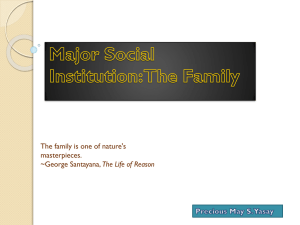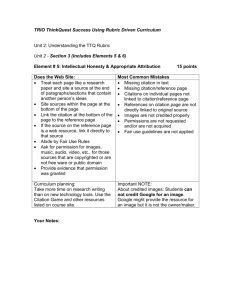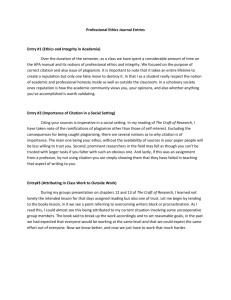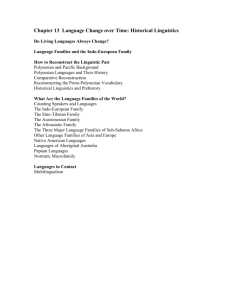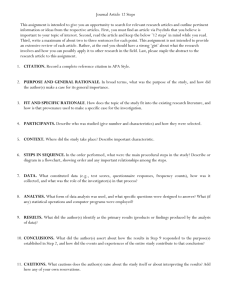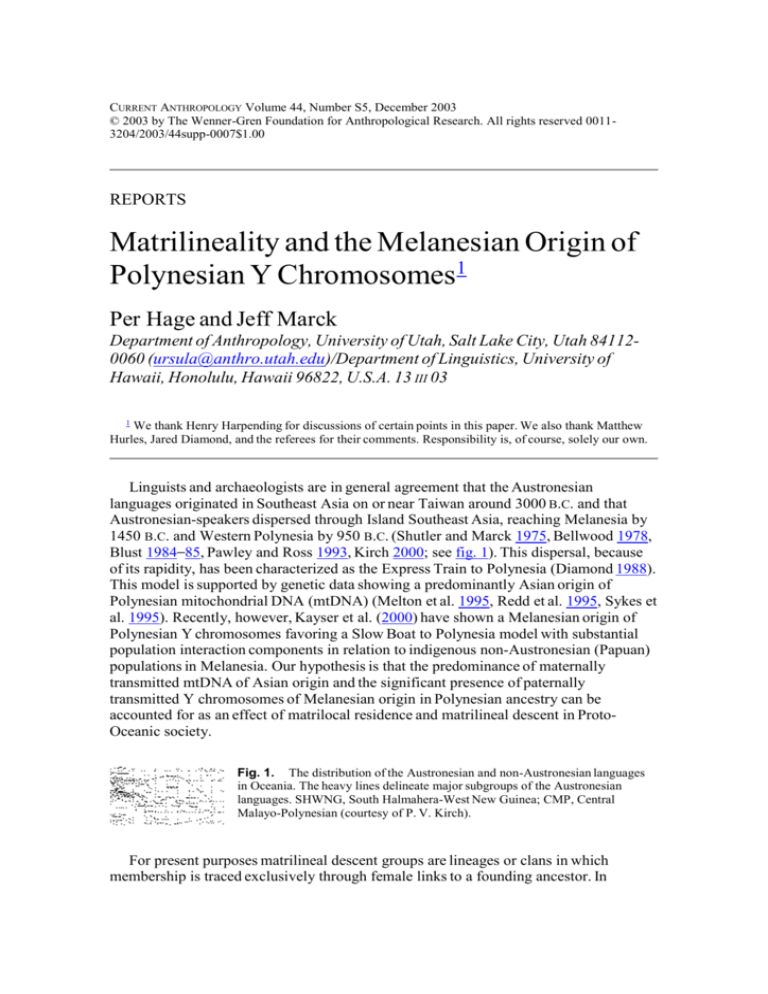
CURRENT ANTHROPOLOGY Volume 44, Number S5, December 2003
© 2003 by The Wenner-Gren Foundation for Anthropological Research. All rights reserved 00113204/2003/44supp-0007$1.00
REPORTS
Matrilineality and the Melanesian Origin of
Polynesian Y Chromosomes1
Per Hage and Jeff Marck
Department of Anthropology, University of Utah, Salt Lake City, Utah 841120060 (ursula@anthro.utah.edu)/Department of Linguistics, University of
Hawaii, Honolulu, Hawaii 96822, U.S.A. 13 III 03
1
We thank Henry Harpending for discussions of certain points in this paper. We also thank Matthew
Hurles, Jared Diamond, and the referees for their comments. Responsibility is, of course, solely our own.
Linguists and archaeologists are in general agreement that the Austronesian
languages originated in Southeast Asia on or near Taiwan around 3000 B.C. and that
Austronesian-speakers dispersed through Island Southeast Asia, reaching Melanesia by
1450 B.C. and Western Polynesia by 950 B.C. (Shutler and Marck 1975, Bellwood 1978,
Blust 1984 85, Pawley and Ross 1993, Kirch 2000; see fig. 1). This dispersal, because
of its rapidity, has been characterized as the Express Train to Polynesia (Diamond 1988).
This model is supported by genetic data showing a predominantly Asian origin of
Polynesian mitochondrial DNA (mtDNA) (Melton et al. 1995, Redd et al. 1995, Sykes et
al. 1995). Recently, however, Kayser et al. (2000) have shown a Melanesian origin of
Polynesian Y chromosomes favoring a Slow Boat to Polynesia model with substantial
population interaction components in relation to indigenous non-Austronesian (Papuan)
populations in Melanesia. Our hypothesis is that the predominance of maternally
transmitted mtDNA of Asian origin and the significant presence of paternally
transmitted Y chromosomes of Melanesian origin in Polynesian ancestry can be
accounted for as an effect of matrilocal residence and matrilineal descent in ProtoOceanic society.
Fig. 1. The distribution of the Austronesian and non-Austronesian languages
in Oceania. The heavy lines delineate major subgroups of the Austronesian
languages. SHWNG, South Halmahera-West New Guinea; CMP, Central
Malayo-Polynesian (courtesy of P. V. Kirch).
For present purposes matrilineal descent groups are lineages or clans in which
membership is traced exclusively through female links to a founding ancestor. In
matrilocal residence a married couple lives "with or near the female matrilineal kinsmen
of the wife" (Murdock 1967). In a matrilineal chiefdom, as hypothesized for ProtoOceanic society (Hage 1999a, Hage and Harary 1996), a man is succeeded by his sister's
son. In a patrilineal descent group membership is traced exclusively through male links
to a founding ancestor and a man is succeeded by his son. In patrilocal residence a
married couple lives "with or near the male patrilineal kinsmen of the husband." In a
cognatic descent group membership is traced through either male or female links.
Double descent (not to be confused with cognatic descent) refers to the presence of both
matrilineal and patrilineal descent groups in the same society.
GENETIC DATA
There are three lineages of Polynesian mtDNA (Melton et al. 1995, Redd et al. 1995,
Sykes et al. 1995). The predominant lineage, accounting for 90 95% of Polynesian
mtDNA, is a haplotype possessing a 9-base-pair intergenic deletion shared with Asian
populations. The greater diversity of this haplotype in Indonesia, the Philippines, and
Taiwan implies an Asian origin and an eastward expansion of Austronesian-speakers
into Polynesia. A second haplotype, accounting for 3.5% of Polynesian mtDNA, is also
found in Melanesia, in Vanuatu and in coastal New Guinea (Sykes et al. 1995).
Kayser et al. (2000) have discovered three haplotypes (lineages) of Polynesian Y
chromosomes. The dominant haplotype, DYS 390.3del/RPS4Y711T, accounts for 82%
of Cook Island, 70% of Western Samoan (Forster et al. 1998, Hagelberg et al. 1999),
26% of Coastal Papua New Guinean, and 9 12% of Indonesian Y chromosomes. This
haplotype is not found in any other Southeast Asian or Asian population. It originated in
Melanesia an estimated 11,500 years ago, long before the intrusion of Austronesianspeakers into Melanesia about 3,500 years ago. A second haplotype, M122C/M9G, is
infrequent in Polynesia, accounting for 7.1 10.7% of Polynesian Y chromosomes, but
frequent in East and Southeast Asia. It probably originated in Asia on the order of 11,000
years ago (Kayser et al. 2000:1242).
Kayser et al. conclude from the Y-chromosome data that the express-train model
should be replaced by a slow-boat model in which the Austronesian-speaking (Oceanic)
ancestors of the Polynesians moved slowly across Melanesia, "mixing extensively" with
indigenous non-Austronesian-speaking (Papuan) populations, leaving behind their genes
and "incorporating" many Melanesian non-Austronesian genes.
This model is consistent with cultural and archaeological evidence of Austronesian
non-Austronesian interaction and with the linguistic "pause" in the spread of the
Austronesian languages between the arrival of the Lapita archaeological culture in 1450
B.C. and about 1100 B.C. On general comparative grounds, some century or centuries of
change would seem to be required to account for the common linguistic innovations that
mark all Austronesian Oceanic languages (and no other [living] Austronesian
languages). Several related studies of Polynesian DNA confirm Kayser et al.'s genetic
data.
Underhill et al. (2001) found that 43% (25/54) of Maori and 41% (7/17) of
Polynesians in their sample had the DYS 390.3 deletion. Following Kayser et al., they
interpret this as unequivocal evidence for an important Melanesian lineage in Polynesian
ancestry. By contrast, the mtDNA 9-base-pair deletion was present in 85% of their Maori
sample; the remaining 15% belonged to European haplogroups.
Hagelberg et al. (1999) found the DYS 390.3 deletion in Melanesia in the Trobriand
Islands (9%), in the Tolai of New Britain (19%), in the Roro of the south coast of New
Guinea (17%) and in western Samoa (70%) but not in Southeast Asia or the New
Guinea Highlands. Forster et al. (1998) found the DYS 390.3 deletion in 6% of Papuan
New Guinea Highlanders and in 25% of north-coast New Guineans.
Lum et al. (1998) cite genetic data showing that Polynesians and Micronesians have
predominantly (95%) Asian mtDNA but share 30% of their nuclear DNA with Near
Oceanic, Papuan-speaking Melanesians.
MATRILOCAL RESIDENCE AND MATRILINEAL DESCENT IN PROTOOCEANIC SOCIETY
Kayser et al.'s model does not specify the type of "intermixing" between
Austronesian- and non-Austronesian-speaking populations in Melanesia, but we suggest
that it took place in the framework of matrilocal residence and matrilineal descent in
Proto-Oceanic society. By "Proto-Oceanic" we mean the language at the end point of its
common development in the Bismarcks before the various incremental and abrupt
dispersals that led to more localized varieties of speech. By "Proto-Oceanic society" we
mean, formally, what can be reconstructed, linguistically, about the social vocabulary of
Proto-Oceanic-speakers and what we infer from that about their society. By "Lapita
society" the archaeologists mean what was surely the same community and what can be
inferred about it through archaeology, comparative ethnography, and comparative
linguistics (Kirch 1997, Green 2002). Proto-Oceanic (Lapita) society was a sophisticated
maritime and horticultural society of Austronesian origin which developed in the region
of the Bismarck Archipelago in western Melanesia around 1500 B.C. The society was
based on an extensive voyaging and exchange network (Kirch 2000). By 1100 to 1200
B.C. daughter societies were expanding eastward, arriving in the Fiji-Tonga-Samoa area
by 950 B.C. (Kirch 2000). After a "long pause" in Western Polynesia of as much as 1,000
years, as evidenced by numerous innovations in Proto-Polynesian (Pawley and Ross
1993), colonization resumed, reaching all islands in Eastern Polynesia by A.D. 1000.
There are two complementary, interconnected perspectives on the relation between
matrilineal institutions and long-distance voyaging (Hage and Marck 2002). The first
perspective is due to Harris (1980, 1985), who argues, generally, that the development of
matrilocal residence and matrilineal descent is favored under conditions of prolonged
male absence for purposes of trade, warfare, or resource exploitation. In contrast to
patrilocal residence, in which absent husbands must rely on wives "whose alien descent
group loyalties override any obligation to [their] husband[s]" (Harris 1980:97),
matrilocal residence allows absent brothers to rely on their lineage sisters to manage
their common corporate interests. Ethnographic examples of this model include the
Iroquois, the Huron, the Mundurucu (Harris 1985:282), and the Haida (Hayden 1993).
Historical and archaeological evidence includes the development of matrilocality in
eastern North America following upon changes in subsistence practices that required
extended male absence in hunting, trading, and raiding expeditions (Harris 1980:97,
citing Trigger 1978). A significant Caribbean parallel is Keegan and Maclachlan's
(1989) reconstruction of the initial colonization of the West Indies as the expansion of a
matrilineal-matrilocal society of long-distance seafarers and traders.
The second perspective is due to Lévi-Strauss (1984), who observed with reference to
Micronesia that males are easily assimilated to matrilineal descent groups. He also
pointed out that matrilineal institutions, because of their inherent instability (resulting
from conflicts between men over the control of their own and their sisters' children), are
apt to disappear when societies become isolated (p. 183):
Some Micronesian societies have lived in relative isolation; elsewhere migrations, wars
and intermarriages have mixed up the populations. Further, we find in the first group of
societies a retreat from matrilineal institutions; left to themselves, these institutions, by
reason of their well known instability, have a tendency to evolve spontaneously towards
other forms. Contrariwise, they provide the second group of societies with a sort of
common denominator and a convenient means ... of incorporating [male] immigrants.
In Micronesia the continuation of matrilineal descent was clearly associated with the
continuation of regular long-distance voyaging (Hage and Marck 2002). In the isolated
atolls of the eastern Carolines (Pingelap, Mokil, and Ngatik), in the outlier atolls of the
Marshalls (Enewetok and Ujelang), and in the atoll groups (Kiribati), where regular
long-distance voyaging declined or never developed, matrilineal descent gave way to
patrilineal, double, or cognatic descent. The same thing happened in western Polynesia
during the long pause, when interisland voyaging came under the control of chiefly elites
involved in a prestige-goods system (Kirch 2000).
In matrilineal societies paternity is not an overriding issue. It matters little who the
father is, since only women continue the lineage. In the Micronesian and larger Oceanic
context, if husbands and fathers were lost (always a possibility in seafaring) they could
be readily replaced by other men, Papuan as well as Oceanic.
In the "classic" theory of kinship (Murdock 1949, Lowie 1950, Fox 1983), the
development of social organization proceeds from changes in residence rules to changes
in descent rules to changes in kinship terminology. By Proto-Oceanic times residence
(matrilocality), descent (matrilineality), and kinship terminology (bifurcate merging)
were perfectly aligned. Many of the daughter societies of Proto-Oceanic retained this
pattern while others underwent changes in residence from matrilocal to avunculocal (a
male-centered residence in a matrilineal society in which a married couple lives with or
near the maternal uncle of the husband), changes in descent from matrilineal to double,
patrilineal, and cognatic, and changes in kinship terminology from bifurcate merging to
generational.
The evidence for matrilineal descent in Proto-Oceanic society as presented in Hage
(1998) can be summarized briefly. Linguistically, Proto-Oceanic kinship terminology
was bifurcate merging in type, with one term for father and father's brother (*tama) and
a separate term for mother's brother (*matuqa) (Milke 1958). Cross-culturally, bifurcatemerging terminologies are associated with unilineal matrilineal or patrilineal descent
85% of the time and (using a slightly different sample) with unilocal residence 91% of
the time (Hage 1999a). The rare bifurcate-merging terminologies found in nonunilineal
(cognatic) societies are best interpreted as survivals of earlier unilineal regimes, bearing
in mind the lag between changes in descent rules and kin terms.
Ethnographically, matrilineal descent is widespread in Oceanic-speaking societies in
Micronesia, in the Caroline and Marshall Islands, and in Island Melanesia in the Huon
Gulf and parts of New Britain and New Ireland (in the Bismarcks), Bougainville, the
Solomon Islands, and Vanuatu (Allen 1984). Double descent (usually interpreted as a
sign of the transition from matrilineal to patrilineal descent [Murdock 1940, Fox 1983])
is also found in Oceanic-speaking societies in Melanesia. It results when an integrated
matrilineal society is undermined by patrilineal institutions, beginning typically with a
shift from matrilocal to patrilocal residence. Patrilineal descent groups then become
important in economic and political contexts, eventually leaving matrilineal descent
groups with few functions other than exogamy, hospitality, and ritual. Classic examples
of double descent in Oceania are Yap in Western Micronesia and Pukapuka in Central
Polynesia. In Island Melanesia double descent is found in a number of societies in the
Admiralty Islands, the Huon Gulf, Vanuatu, and Fiji (Murdock 1967). In Murdock's
World Ethnographic Atlas (1967) 74% (26/35) of all unilineal Oceanic-speaking
societies have either matrilineal or double descent. Historical linguistic evidence from
Island Melanesia (Malaita) reveals shifts from matrilineal to patrilineal descent but not
the converse (Blust 1986 87).
Not all Oceanic-speaking societies are matrilineal, but the majority of them display a
matricentric orientation that we interpret as the historical residue of a matrilineal ProtoOceanic society. If Proto-Oceanic society was patrilineal, one would expect a continuing
patricentric orientation in daughter societies. In Burton et al.'s (1996) analysis of social
structure in world ethnographic regions, matricentric traits include "localized or
dispersed matrilineal groups, matrilocal or uxorilocal residence, monogamy, and the
absence of marriage exchange ... generational aunt terms, bifurcate merging aunt terms
and Crow cousin terms" (p. 93). Oceanic-speaking societies in Melanesia, Polynesia, and
Micronesia are generally matricentric (fig. 2).
Fig. 2. Social structural traits of Oceanic-speaking societies based on Burton et
al. (1996). M, Melanesia; P, Polynesia; I, Micronesia (from Hage 1998, courtesy
of the Polynesian Society).
The relative unimportance of paternity in matrilineal societies in Oceania is clearly
illustrated in the matrilineal chiefdoms of the Marshall Islands in eastern Micronesia
(Hage and Harary 1996). Male ancestors were often omitted from chiefly genealogies. In
the words of an early ethnographer, "When Kabua [a paramount chief of the Ralik chain
of the Marshalls] dictated the genealogical tree of his ancestors to me and mentioned
only women, I asked him to name the men too as is generally customary in Polynesia. He
laughed and said that they were completely irrelevant, and therefore he did not know
them" (Krämer 1906:431). Children in the Marshalls were considered chiefly (iroij) if
their mothers were chiefly.
DISCUSSION
It is sometimes assumed in population genetics that patrilocal residence and
patrilineal descent are the norm (Cavalli-Sforza 2000), but there are significant numbers
of matrilineal societies in the world (Murdock 1967). If the Austronesian ancestors of
the Polynesians were patrilineal, one would expect to find Polynesian Y chromosomes of
predominantly Asian origin and mtDNA of mixed Asian and Melanesian nonAustronesian origin, the frequency of the latter depending on the frequency with which
Austronesian-speaking men married indigenous non-Austronesian-speaking women.
The predominance of Asian mtDNA and the high frequency of Melanesian Y
chromosomes in Polynesian DNA imply the presence of matrilocal residence and
matrilineal descent in Proto-Oceanic society. While founder effects in Polynesia and at
various points along the way from the northwestern Melanesian Proto-Oceanic
homeland could skew the actual level of Melanesian contributions to the Y-chromosome
situation amongst Proto-Oceanic-speakers, it would be unlikely for the mitochondrial
DNA to be so profoundly skewed in the opposite direction by early Polynesian
settlement times. The founding population of Polynesia was dominated by Southeast
Asian mitochondrial DNA and Melanesian non-Austronesian Y-chromosome DNA, and
such a skewed sex-based difference is more likely the result of the long-term systematic
effects of ancestral marital patterns than the chance result of compounded founder
effects from the Proto-Oceanic homeland along the route to Western Polynesia. The
genetic data are consistent with the linguistic and comparative ethnographic data
supporting a hypothesis of matrilineal descent in the early Oceanic ancestors of the
Polynesians. It would not have taken many generations to reach a high level of
Melanesian Y-chromosome admixture in Polynesian DNA. If 10% of the Ychromosome DNA in each generation came from outsiders, in 300 years (12
generations) the proportion of original DNA would have been (.9) 12 28%.
Two studies of matrilineality and genetic diversity lend further support to our model.
Oota et al. (2001) have shown that genetic diversity varies with residence rules. In a
comparison of six closely related groups three patrilocal and three matrilocal from
northern Thailand, mtDNA diversity was higher in all the patrilocal than in any of the
matrilocal groups. Conversely, Y-STR haplotype diversity was higher in all the
matrilocal than in any of the patrilocal groups. According to these researchers, the
linguistic, cultural, regional, and economic similarities among the six groups make it
unlikely that some factor other than residence could account for these differences.
An analogue to our model of the Oceanic settlement of Polynesia is provided by the
Herero (Henry Harpending, personal communication). The Herero, pastoralists who
represent the southwestern arm of the Bantu expansion (Pennington and Harpending
1993), are self-consciously ethnic, and group membership is determined exclusively by
the mother. There are many liaisons with non-Herero, and offspring of these liaisons are
Herero only if their mothers are Herero. One manifestation of this mating pattern is
reduced genetic diversity compared with that of other Bantu-speaking people in southern
Africa (Harpending and Chasko 1976). Another is lack of mitochondrial diversity,
indicating bottlenecking and a restricted maternal ancestry. Vigilant et al. (1991)
describe mitochondrial DNA sequences of a world sample of 189 people including 27
Herero. Whereas the sample of 162 non-Herero had 125 distinct sequences the sample of
27 Herero had only 10. An expanding group with strong matrilineal ideology like that of
the Herero would show, centuries later, a restricted and geographically specific origin of
mitochondrial DNA but a diverse and widespread origin of Y-chromosome and nuclear
DNA. This is the pattern that we propose to account for the discrepant origins of
Polynesian mitochondrial and Y-chromosome DNA.
It has been put to us that the significant presence of Melanesian non-Austronesian Y
chromosomes in Polynesian DNA could be more simply explained by a skewed sex
ratio more males in the boats than females. We would argue that sex ratios in
colonizing expeditions were not markedly skewed. As Kirch (1997) observes, the Lapita
expansion favored a high rate of population growth. The vulnerability to extinction of
small colonizing "propagules" would have favored more nearly balanced sex ratios. If
the social motivation for the Lapita expansion was primogeniture (Kirch 1997; Hage
1999a, b), the colonizing expeditions were probably led by junior, polygynous
collaterals of chiefs. It is hard to imagine that men would have set off without women.
Further, there is no need to assume that women would have been in the way on
colonizing expeditions; they could well have been part of the crew. Lum et al. (1998)
have suggested the possibility of male-biased gene flow after initial colonization in the
context of predominantly male interisland voyaging and matrilineal descent. The details
of this scenario are not given. In our view matrilineal descent and voyaging networks
were part of the colonization process itself.
Not all population geneticists are in agreement with the analysis of genetic data in
Kayser et al. (2000), Underhill et al. (2001), and Hagelberg et al. (1999). Su et al. (2000)
found that one Y-chromosome haplotype, M4G/MST/M9G, is present in Melanesia but
not in Polynesia and concluded that "the contribution of Melanesian Y-chromosomal
haplotypes to the Polynesian expansion is very low or negligible" (p. 8227), but they did
not include in their analysis the DYS 390.3 del/RPS4Y711T haplotype. Hurles et al.
(2002) found that two lineages account for 81% of nonadmixed Polynesian Y
chromosomes. Lineage 26.4 is found in Polynesia and Southeast Asia; lineage 10.2 is
found only in Polynesia and Melanesia, but "it appears that 10.2 owes its ancestry, much
like that of its phylogenetic predecessor, the DYS390.3 chromosomes (Kayser et al.
2000), to a source population in Melanesia and/or eastern Indonesia" (p. 300).
Oppenheimer and Richards (2001a, b) believe that a subgroup of the mitochondrial
haplotype with the intergenic 9-base-pair deletion called "the Polynesian motif"
originated in Wallacea in eastern Indonesia 17,000 years B.P. (95% credible region:
5,500 34,500 years). They also suggest a possible eastern Indonesian origin of the Ychromosome haplotype DYS 390.3. They argue that Austronesian origins lie within
tropical Southeast Asia, but with the exception of Dyen (1965) and Terrell, Kelly, and
Rainbird (2001), no linguists and few archaeologists credit this idea. As Diamond (2001)
has written, they overlook the linguistic, archaeological, and genetic evidence that
locates Austronesian origins in Taiwan and ultimately China.
Oppenheimer and Richards (2001a, b) and other geneticists are now making regular
but unreferenced claims that the "linguists," "linguistics," or "the standard archaeo-
linguistic model" do not allow much "mixing" of Austronesian-speakers with
populations they encountered in their journey through time and space to Remote
Oceania. While Oppenheimer and Richards contrast this with Terrell's (1998, Terrell et
al. 2001) "entangled bank" model, neither Oceanic linguists nor theoretical linguists
have actually made anything resembling a "no-mixing" claim. In this and his Wallacea
homeland "model" of Austronesian origins, Terrell has simply created "linguistic"
models with no foundation in linguistics.
The "express-train" and "slow-boat" terminologies refer, in current parlance amongst
biological scientists, not to the speed with which Austronesian dispersal/encroachment
into the Pacific occurred but to the character of the social interactions along the way. The
amount of time it took was already known to be about 500 years in Oceania. This figure
will change if the archaeology changes, not if the biological science changes. Neither the
linguists nor the archaeologists have said or implied that the apparent speed of dispersal
meant that Austronesian-speakers were not interacting with non-Austronesian-speakers
along the way. The contrast between express trains and slow boats, although convenient
for geneticists' (Lum et al. 1998; Kayser et al. 2000; Oppenheimer and Richards 2001a,
b; Underhill et al. 2001) purposes, is misleading. Most archaeologists, if forced to use
catch phrases, would prefer some form of Green's (1990) Triple I intrusion, innovation,
and integration model of Austronesian (Oceanic) and non-Austronesian interaction.
The question is, how did these populations interact? Here we have suggested an answer:
they interacted as most matrilineal societies do.
CONCLUSION
We propose that the predominance of maternally transmitted mtDNA of Asian origin
and the significant presence of paternally transmitted Y chromosomes of Melanesian
non-Austronesian origin in Polynesian ancestry can be accounted for as an effect of
matrilineal institutions of residence and descent in Austronesian Proto-Oceanic society.
The matrilineal hypothesis is supported by abundant linguistic, ethnographic, and crosscultural evidence, and the genetic data are consistent with this evidence.
References Cited
1984. Elders, chiefs, and big men: Authority, legitimation, and
political evolution in Melanesia. American Ethnologist 11:20 41. First citation
in article
BELLWOOD, P. S. 1978. Man's conquest of the Pacific: The prehistory of
Southeast Asia and Oceania. Oxford: Oxford University Press. First citation in
article
BLUST, R. 1984 85. The Austronesian homeland: A linguistic perspective. Asian
Perspectives 26:45 67. First citation in article
. 1986 87. Language and culture history: Two case studies. Asian
Perspectives 27:205 27. First citation in article
BURTON, M. L., C. C. MOORE, J. W. M. WHITING, AND A. K. ROMNEY. 1996.
Regions based on social structure. CURRENT ANTHROPOLOGY 37:87 123. First
citation in article | Full Text
ALLEN, M.
2000. Genes, peoples and languages. New York: North
Point Press. First citation in article
DIAMOND, J. 1988. Express train to Polynesia. Nature 336:307 8. First citation
in article
. 2001. Reply [to Oppenheimer and Richards]. Nature 410:167. First
citation in article
DYEN, I. 1965. The lexicostatistical classification of the Austronesian languages.
Indiana University Publications in Anthropology and Linguistics and
International Journal of American Linguistics Memoir 19. First citation in article
CAVALLI-SFORZA, L. L.
FORSTER, P., M. KAYSER, E. MEYER, L. ROEWER, H. PFEIFFER, H. BENKMAN, ET
AL. 1998. Phylogenetic resolution of complex mutational features at Y-STR D4S
390 in Aboriginal Australians and Papuans. Molecular Biological Evolution
15:1108 11. First citation in article
FOX, R. 1983. Kinship and marriage. Cambridge: Cambridge University Press.
First citation in article
GREEN, R. 1990. "The Lapita cultural complex: Current evidence and proposed
models." Indo-Pacific prehistory: Proceedings of the 14th Congress of the IndoPacific Prehistory Association, pp. 295 305. Canberra: Indo-Pacific Prehistory
Association. First citation in article
. 2002. "Rediscovering the social aspects of ancestral Oceanic societies
through archaeology, linguistics, and ethnology," in Fifty years in the field:
Essays in honour and celebration of Richard Shutler Jr's archaeological career.
Edited by S. Bedford, C. Sand, and D. Burley, pp. 21 35. New Zealand
Archaeological Association Monograph 25. First citation in article
HAGE, P. 1998. Was Proto-Oceanic society matrilineal? Journal of the
Polynesian Society 107:365 79. First citation in article
. 1999a. Reconstructing ancestral Oceanic society. Asian Perspectives
38:200 228. First citation in article
. 1999b. Linguistic evidence for primogeniture and ranking in ProtoOceanic society. Oceanic Linguistics 38:366 75. First citation in article
HAGE, P., AND F. HARARY. 1996. Island networks. Cambridge: Cambridge
University Press. First citation in article
HAGE, P., AND J. MARCK. 2002. Proto-Micronesian kin terms, descent groups,
and interisland voyaging. Oceanic Linguistics 41:159 70. First citation in article
HAGELBERG, E., M. KAYSER, M. NAGY, L. ROEWERS, H. ZIMDAHL, M. KRAWCZAK,
ET AL. 1999. Molecular genetic evidence for the human settlement of the Pacific:
Analysis of mitochondrial DNA, Y chromosome, and HLA markers.
Philosophical Transactions of the Royal Society of London 354:141 52. First
citation in article
HARPENDING, H. C., AND W. J. CHASKO. 1976. "Heterozygosity and population
structure in Southern Africa," in The measures of man. Edited by E. Giles and J.
Friedlaender, pp. 214 29. Cambridge: Peabody Museum Press. First citation in
article
HARRIS, M. 1980. Cultural materialism. New York: Random House. First
citation in article
. 1985. 4th edition. Culture, people, nature. New York: Random House.
First citation in article
HAYDEN, B.
1993. Archaeology. New York: W. H. Freeman. First citation in
article
HURLES, M. E., J. NICHOLSON, E. BOSCH, C. RENFREW, B. C. SYKES, AND M. A.
JOBLING. 2002. Y chromosomal evidence for the origins of Oceanic-speaking
peoples. Genetics 160:289 303. First citation in article
KAYSER, M., S. BRAUER, G. WEISS, P. A. UNDERHILL, R. LUTZ, W.
SCHIEFENHOVEL, AND M. STONEKING. 2000. Melanesian origin
of Polynesian Y
chromosomes. Current Biology 10:1237 46. First citation in article
KEEGAN, W. F., AND M. D. MACLACHLAN. 1989. The evolution of avunculocal
chiefdoms. American Anthropologist 91:613 30. First citation in article
KIRCH, P. 1997. The Lapita peoples. Oxford: Blackwell. First citation in article
. 2000. On the road of the winds. Berkeley: University of California
Press. First citation in article
KRÄMER, A. 1906. Hawaii, Ostmikronesien und Samoa. Stuttgart: Strecker and
Schroeder. First citation in article
LÉVI-STRAUSS, C. 1984. Anthropology and myth: Lectures, 1951 1982. Oxford:
Blackwell. First citation in article
LOWIE, R. H. 1950. Social organization. London: Routledge and Kegan Paul.
First citation in article
LUM, J. K., R. L. CANN, J. J. MARTINSON, AND L. B. JORDE. 1998. Mitochondrial
and nuclear genetic relationships among Pacific Island and Asian populations.
American Journal of Human Genetics 63:613 24. First citation in article
MELTON, T., R. PETERSON, A. J. REDD, N. SAHA, A. S. M. SOFRO, J. MARTINSON, ET
AL. 1995. Polynesian genetic affinities with Southeast Asian populations as
identified by mtDNA analyses. American Journal of Human Genetics 57:403
14. First citation in article
MILKE, W. 1958. Ozeanische Verwandtschaftsnamen. Zeitschrift für Ethnologie
82:226 29. First citation in article
MURDOCK, G. P. 1940. Double descent. American Anthropologist 42:555 61.
First citation in article
. 1949. Social structure. New York: Free Press. First citation in article
. 1967. World ethnographic atlas. Pittsburgh: University of Pittsburgh
Press. First citation in article
OOTA, H., W. SETTHEETHAM-ISHIDA, D. TIWAWECH, T. ISHIDA, AND M.
STONEKING. 2001. Human mtDNA and Y-chromosome variation is correlated
with matrilocal versus patrilocal residence. Nature Genetics 29:20 21. First
citation in article
OPPENHEIMER, S., AND M. RICHARDS. 2001a. Fast trains, slow boats, and the
ancestry of the Polynesian Islanders. Scientific Progress 84:157 81. First
citation in article
. 2001b. Slow boat to Melanesia? Nature 410:166 67. First citation in
article
PAWLEY, A., AND M. ROSS. 1993. Austronesian historical linguistics and culture
history. Annual Review of Anthropology 22:425 59. First citation in article
PENNINGTON, R. L., AND H. C. HARPENDING. 1993. The structure of an African
pastoralist community: Demography, history, and ecology of the Ngamiland
Herero. Oxford: Oxford University Press. First citation in article
REDD, A. J., N. TAKEZAKI, S. T. SHERRY, S. T. MC GARVEY, A. S. M. SOFRO, AND M.
STONEKING. 1995. Evolutionary history of the C011/tRNALys intergenic 9 base
pair deletion in human mitochondrial DNAs from the Pacific. Molecular
Biological Evolution 12:604 15. First citation in article
SHUTLER, R., JR., AND J. MARCK. 1975. On the dispersal of the Austronesian
horticulturalists. Archaeology and Physical Anthropology in Oceania 10:81
113. First citation in article
SU, B., L. JIM, P. UNDERHILL, J. MARTINSON, N. SAHA, S. T. MC GARVEY, M. D.
SHRIVER, J. CHU, P. OEFNER, R. CHAKRABORTY, AND R. DEKA. 2000. Polynesian
origins: Insights from the Y chromosome. Proceedings of the National Academy
of Sciences, U.S.A. 97:8225 28. First citation in article
SYKES, B., A. LEIBOFF, J. LOW-BEER, S. TETZNER, AND S. RICHARDS. 1995. The
origins of the Polynesians: An interpretation from mitochondrial lineage
analysis. American Journal of Human Genetics 57:1463 75. First citation in
article
TERRELL, J. 1998. History as a family tree, history as an entangled bank:
Constructing images and interpretations of prehistory in the South Pacific.
Antiquity 62:642 57. First citation in article
TERRELL, J., K. M. KELLY, AND P. RAINBIRD. 2001. Foregone conclusions? In
search of "Papuans" and "Austronesians." CURRENT ANTHROPOLOGY 42:97
124. First citation in article
TRIGGER, B. 1978. Iroquois matriliny. Pennsylvania Archaeologist 48:55 65.
First citation in article
UNDERHILL, P. A., G. PASSARINO, A. A. LIN, S. MARSUKI, P. J. OEFNER, L. L.
CAVALLI-SFORZA, AND G. K. CHAMBERS. 2001. Maori origins, Y-chromosome
haplotypes, and implications for human history in the Pacific. Human Mutation
17:271 80. First citation in article
VIGILANT, L., M. STONEKING, H. HARPENDING, K. HAWKES, AND A. WILSON.
1991. African populations and the evolution of human mitochondrial DNA.
Science 253:1503 7. First citation in article

